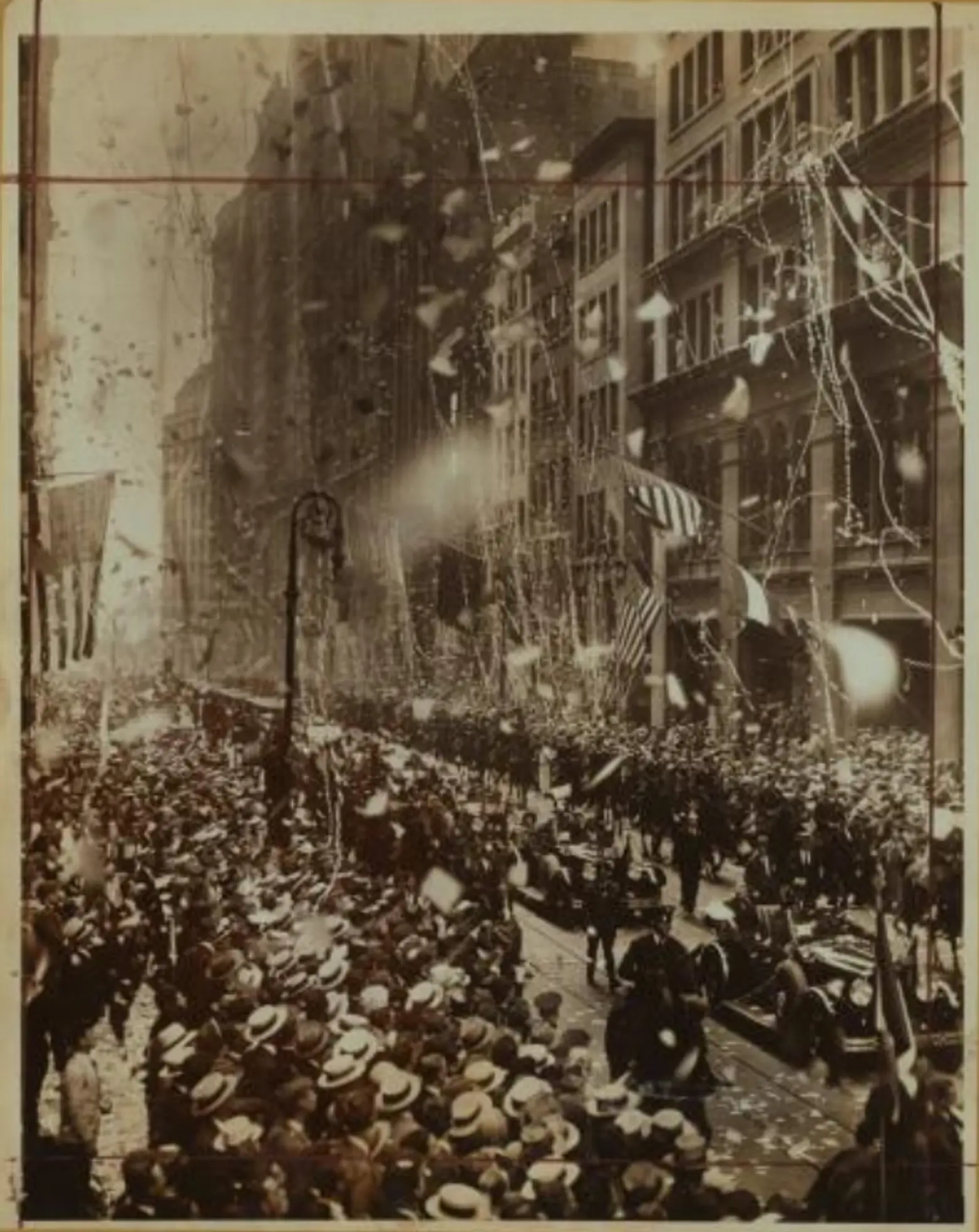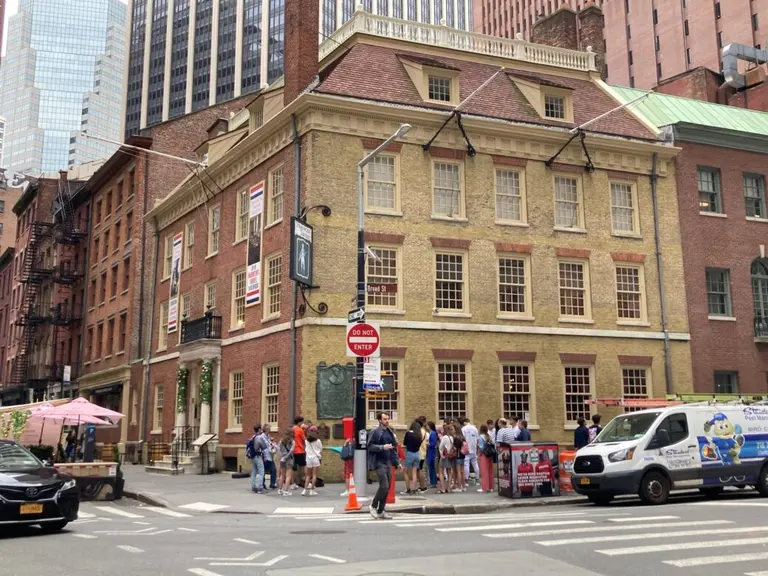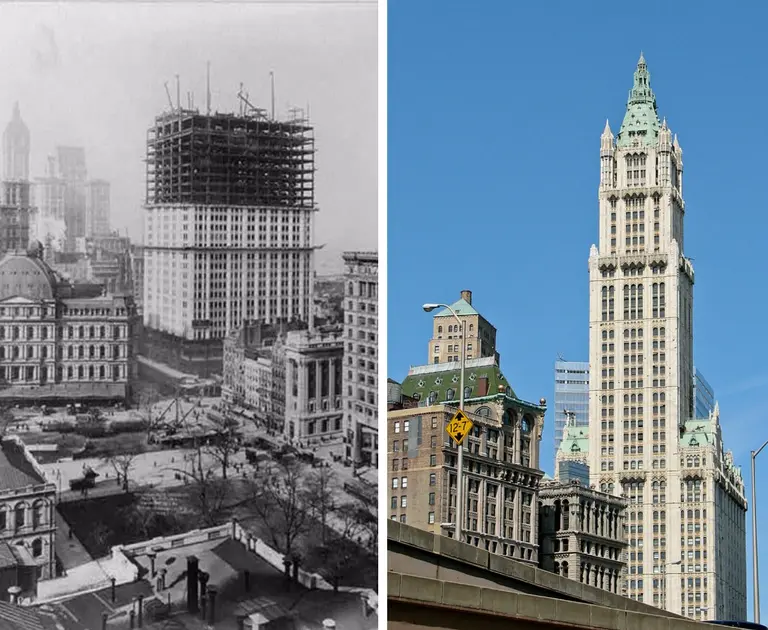From the Statue of Liberty to the U.S. Women’s Soccer Team: A history of NYC’s ticker-tape parades

“Gertrude Ederle Parade,” 1926, via Wikimedia Commons
When the U.S. Women’s Soccer Team walks along the Canyon of Heroes from Broadway up to City Hall today in the city’s 207th official Ticker-Tape Parade, they will be in good company. For more than 120 years, politicians, aviators, adventurers, generals, and sports teams have been showered with felicitations and falling office paper. But this beloved tradition actually originated spontaneously on October 28, 1886, when Wall Streeters began throwing ticker-tape out their office windows as an enraptured public marched down Broadway to the Battery to celebrate the dedication of “Liberty Enlightening the World,” or the Statue of Liberty as we know her. Ahead, learn the entire history of Ticker-Tape Parades in NYC, from George Washington and Teddy Roosevelt to Jesse Owens and Joe DiMaggio.
 “Ticker tape and confetti floating onto the motorcade carrying the crew of the Bremen, and the crowds assembled to greet,” 1928, via Wikimedia Commons
“Ticker tape and confetti floating onto the motorcade carrying the crew of the Bremen, and the crowds assembled to greet,” 1928, via Wikimedia Commons
The City took to its streets (and its windows) again on April 30, 1889, for the centennial of George Washington’s inauguration. Both ticker-tape and rose petals rained on Broadway for the occasion. That ticker-tape parade was a fitting fete because ticker-tape parades are an industrial-age update of New York’s Colonial-era public celebrations and parades. The invention of the “ticker” machine, for recording stock quotes, coupled with the rise of New York’s early “tall office buildings,” and eventual skyscrapers, gave birth to the “Canyon” of Broadway and made possible a new kind of celebration.

“John J Pershing – returns to America – 1919,” via Wikimedia Commons
Early 20th Century parades followed in that mold, honoring Presidents, Generals, and Heads of State, including Teddy Roosevelt – who returned from an African safari in 1910 to the then-largest-ever parade, complete with a million spectators, a 21-gun salute, an a 150-man Rough Rider brigade – General John Pershing, commander of the American Expeditionary Forces in World War I, and visiting Belgian monarchs Albert and Elizabeth.
Sports stars began to join Generals on the Canyon of Heroes in the 1920s and ‘30s. In 1924, the U.S. Olympic team became the first sports team to earn a ticker-tape parade, when it returned, overwhelmingly victorious, from that year’s summer Olympics in Paris. They were followed by stars like Jesse Owens, the first African American athlete to be celebrated with a ticker-tape parade, and Gertrude Ederle, the first woman to earn a ticker-tape parade, for her feat as the first woman to swim the English Channel.
At the same time, aviators were coming down the Canyon like it was a runway. Just a few of those who were drenched in ticker-tape include: Commander Richard E. Byrd and Floyd Bennett for the first successful flight over the North Pole; Charles Lindbergh, whose first solo flight across the Atlantic defined the ‘20s; Dr. Hugo Eckener, for the first commercial transatlantic flight (made by Zepplin!); Wiley Post for the first solo flight around the world; and of course, Amelia Earhart, First Lady of the Air.
 “[Welcome to] Eckener, Hugo,” 1928, via NYPL Digital Collections
“[Welcome to] Eckener, Hugo,” 1928, via NYPL Digital Collections
By the 1950s, ticker-tape parades reached what we might call their mature form. Just like so many other Americans do when they come of age, ticker-tape parades even got their own car. Enter the 1952 Chrysler Imperial Parade Phaeton, which remains New York City’s official parade car. Since it entered the city’s fleet, the Phaeton has logged more than 27,000 miles on the parade route, carrying the likes of JFK, Neil Armstrong, and Joe DiMaggio.
The car became such a seasoned road warrior because the city threw a whopping 130 ticker-tape parades between 1945 and 1965. Because ticker-tape parades allowed for public displays of patriotism, they became an official facet of American Cold War diplomacy. Accordingly, just about every visiting dignitary and their brother got a parade up Broadway. In fact, the practice became so routine, that in May 1950, the City staged three ticker-tape parades in one week.
It got to the point that the City itself had to deliver confetti to buildings along Broadway, just to make sure there was something to throw; New Yorkers began to lose interest in the practice altogether. Finally, in 1966, Mayor Lindsay swept into office on an anti-parade platform: that year, he announced his administration would discontinue ticker-tape parades in favor of more formal celebrations.

Apollo 11 Astronauts cruising up Broadway in New York’s official parade car, the 1952 Chrysler Imperial Parade Phaeton, 1969, via Wikimedia Commons
Obviously, this policy went out the window when Americans went into orbit. Four million people had turned out in 1962 to welcome John Glenn when he became the first man to orbit the Earth, and four million more lined the streets to fete Neil Armstrong and Buzz Aldrin in 1969 for making a giant leap for Mankind.
That same summer, the Mets won the World Series and inaugurated the tradition of ticker-tape parades for World Series champions. Since then, sports stars have dominated the parade route. Indeed, when the US Women’s soccer team makes its way up Broadway this morning, it will be on familiar ground. The team was also a recipient of the city’s last ticker-tape parade, in 2015. Four years later, they’re still on top of the world.
































